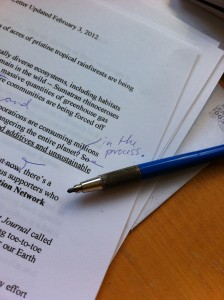Is That Really True? Storytelling Ethics Part 1
/ I've been quiet recently -- a combination of end-of-the-school-year craziness and looming deadlines. Now, summer seems on the verge of appearing here in the Pacific Northwest, and in between sunny runs by the reservoir and neighborhood cookouts, I'm going to try to put in a few more appearances here at the blog.
During the non-stop action of the last month, I've been spending a lot of time mulling over a few really interesting questions someone recently asked me about storytelling ethics.
I've been quiet recently -- a combination of end-of-the-school-year craziness and looming deadlines. Now, summer seems on the verge of appearing here in the Pacific Northwest, and in between sunny runs by the reservoir and neighborhood cookouts, I'm going to try to put in a few more appearances here at the blog.
During the non-stop action of the last month, I've been spending a lot of time mulling over a few really interesting questions someone recently asked me about storytelling ethics.
How true does a story we use in fundraising have to be? Can we change names? Can we fudge details or timelines? Do people ever make up stories entirely?
I gave a fairly evasive answer: how literally truthful you are in your organizational storytelling is up to each organization to decide.
But I was curious how others might answer that same question. As I began researching the issue, I started contemplating ideas of truth and fiction and where we draw the line between the two.
Let me say up front that I still don't have a better answer to the original question. I do think it's a discussion each organization needs to have internally and then convey to any consultants or writers they bring on board.
But I did find some helpful basic guidelines to follow as you have these internal conversations.
A Basic Ethical Stance
In my initial burst of research, I came across this article by Joanne Fritz on the ethics of changing details in stories. She interviews two noted experts -- Lisa Sargent of Sargent Communications and Pamela Grow of Simple Development Systems. Both take a firm stance on changing details, agreeing that it is sometimes necessary to protect the identities, particularly of young people, of those whose stories you want to share.
They urge nonprofits to take three key steps: get written permission, alter or hide key personal details, and be transparent with your donors.
This is great advice, particularly for nonprofits working directly with clients, such as a nonprofit helping clothe foster children, or a drug addiction support organization, for two examples. Activist groups and other large-scale groups may be gathering stories that are of a less personal nature, so they may not have to worry about protecting identities as much.
But from what I see in the mail that comes across my desk, the toughest thing about these standards is the transparency portion. Sure, you can simply add a disclaimer into your letter. But please be clever and creative about how you do that.
Because as soon as you say, "some of this story isn't 100% true" your donor is going to stop reading your pitch and start examining your story to see what details sound made up.
And once you lose 'em, you lose the chance of a gift.
If you need to use a disclaimer, weave it into your story. Instead of a an asterisk next to a message saying "Details have been changed to protect identities" try appealing to your donor's sense of empathy:
"Joanie was really nervous about people learning her secrets. But she knows how important it is to get her story out there, so she's agreed to let me share it with you, as long as I protect her privacy."
Adhering to strict ethical rules does not have to kill your creativity, nor should it. Always try to push yourself to find the most organic and natural way to adhere to your standards, and your nonprofit copywriting will shine that much brighter.
The rules I mention above are a great starting point. But I think storytelling ethics deserve more thoughtful consideration. So please check in later this week for more thoughts on storytelling, ethics and where (and how!) to draw the line in your own organization.
